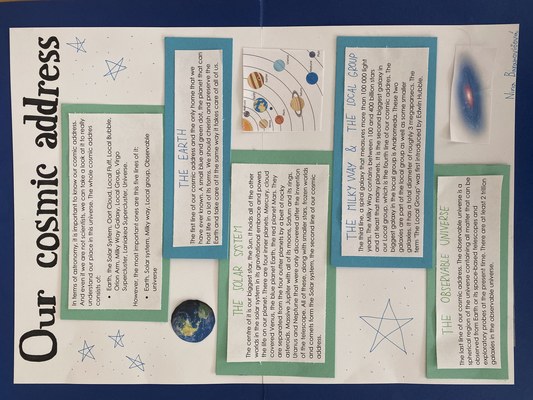Galaxies, stars, planets, moons and other objects in space are so beautiful.
We can learn more about them.
1, First we can visit the official website of Hubble Space Telescope and admire their photos and posters.
https://hubblesite.org/
2, In terms of astronomy it is important to know our cosmic address. So we start our study with it.
Our first graders prepared an example of the summary of basic facts:
The first line of our cosmic address is the Earth – our only home that we have ever known. Our nearest neighbour is the Moon – it has no sky, no oceans, no life, only scars of cosmic impacts.
Our star - the Sun powers all the life in our blue planet and holds all the other worlds in the solar system in its gravitational embrace. It starts with Mercury and Venus. Then there is Mars and a belt of rocky asteroids. After four inner planets there are four outer giant planets: Jupiter (which has more mass than all the other planets combined), Saturn (which is ringed by falling snowballs) and Uranus and Neptune (which were discovered only after the invention of the telescope). Beyond the outermost planets there are thousands of frozen worlds like Pluto and trillion of frozen comets in the Oort cloud. This is the second line in our address – the Solar system.
The third line in our cosmic address is the Milky Way – a spiral galaxy which measures about 100 000 light years across. Together with the galaxy in Andromeda and some smaller galaxies they form the Local Group of galaxies –the fourth line of the address. The Virgo Supercluster is one of about 10 million superclusters in the observable universe it is the fifth line of our address.
Groups of galaxies form superclusters and superclusters make all the observable universe – it means a network of 100 billion galaxies. And this is the last line of our cosmic address. For now.
Do you know?
How many km are there in 1 ly?
Is 1 billion in English the same as 1 billion in Lithuanian/Polish/Slovak language?
We prepared some posters to make it easy to remember:
